When learning Spanish, no matter what, you’ll have to deal with Spanish tenses at some point. This is because verb tenses allow you to accurately indicate when an action is happening and who is performing it. Like yourself, many students often wonder how many tenses the Spanish language has.
The Royal Spanish Academy gathers 17 Spanish tenses. However, contemporary Spanish speakers only use 14 tenses in their daily conversations. The preterite perfect, the future subjunctive, and the future perfect subjunctive are the three tenses that are not common in daily Spanish.
Spanish verb tenses are a key piece of your learning journey. To help you start on the right foot, I’ve prepared this guide where you’ll find all the essential information you need to understand Spanish tenses. These are the topics you’ll learn in this guide:
- Spanish Common Tenses
- Indicative tenses
- Indicative compound tenses
- Imperative
- Subjunctive tenses
- Spanish Moods
- Recommended Order to Learn Spanish Tenses
- Best Ways to Learn Tenses
- Key Points About Spanish Tenses
Common Spanish Tenses You Should Know
In any language, verb tenses are essential because they indicate when an action happens. In simple words, they allow you to express if something happened in the past, present, or future in relation to the moment you speak.
In addition to this, when conjugating a verb in Spanish, you are also specifying who is the person doing that action. Check these examples:
¿Estudiaron para el exámen?
Did you guys study for the test?
Todos los sábados compramos hamburguesas.
We buy burgers every Saturday.
As mentioned above, there are 17 Spanish tenses in total. 14 of them are very common and, as a result, we use them on a daily basis. The remaining 3 tenses are old-fashioned and, because of this, you may find them in old books or movies.
Just in case you were wondering, these are the tenses you need to know in Spanish:
- Present
- Preterite
- Imperfect
- Future
- Conditional
- Present Perfect
- Spanish Pluperfect
- Future Perfect
- Conditional Perfect
- Imperative
- Present Subjunctive
- Imperfect Subjunctive
- Spanish Present Subjunctive
- Past Perfect Subjunctive
Take Note: Many learners wonder what’s the difference between Spanish tenses. In a broad definition, Spanish tenses are distinguished from each other because of their conjugation endings and the fact that each tense refers to different moments in time.
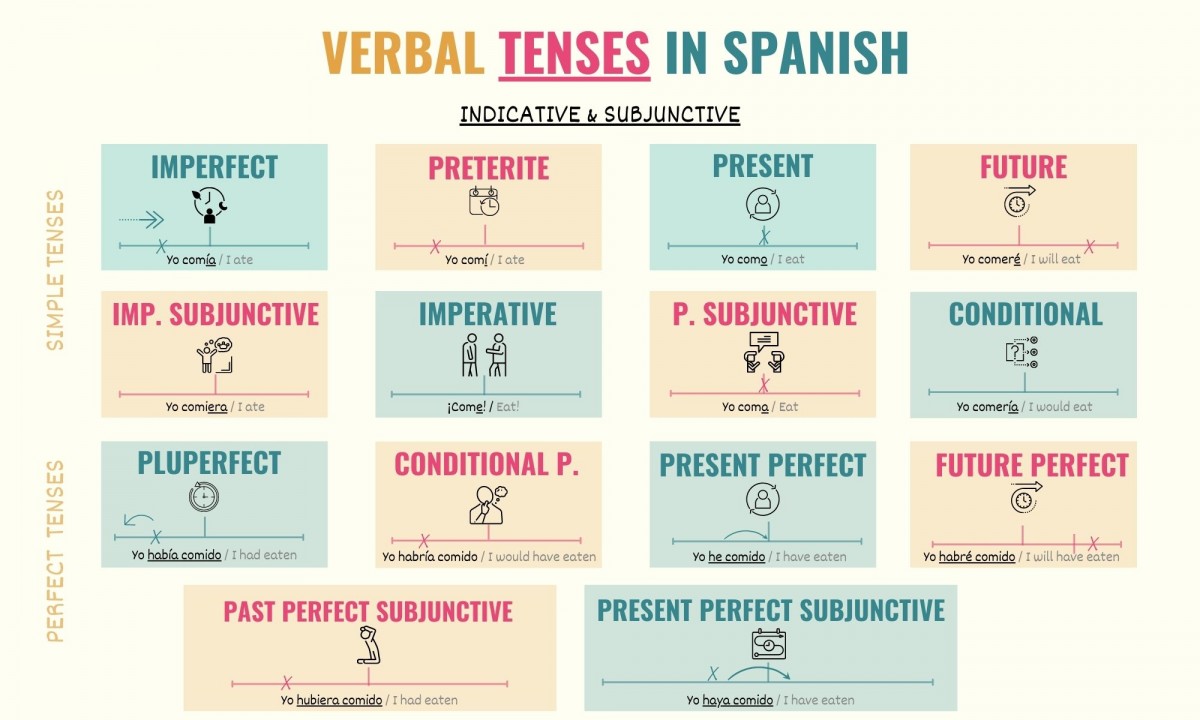
Learning Spanish?
Join the Tell Me In Spanish community and get a copy of my step-by-step Spanish Learner’s Roadmaps and tricky synonyms & vocab cheat sheets.
Indicative Tenses
Spanish indicative tenses are a good place to start for beginner learners. Below, you’ll find the list of the tenses that fall into this mood and the conjugation endings you need to follow.
Spanish present tense
As its name suggests, the Spanish present tense indicates that an action takes place in the present. As a result, this tense is commonly used to:
- Talk about current habits and routines.
- Describe the characteristics of a person or object.
- Refer to actions that are taking place at the moment of speaking.
To conjugate to the Spanish present tense, you need to add the following endings to the verb stem:
| Personal pronoun | -AR verbs | -ER verbs | -Ir verbs |
|---|---|---|---|
| Yo | -o | -o | -o |
| Tú | -as | -es | -es |
| Él / Ella / Usted | -a | -e | -e |
| Nosotros | -amos | -emos | -imos |
| Vosotros | -áis | -éis | -ís |
| Ellos | -an | -en | -en |
Here are some examples of sentences in the present tense:
[Verb conjugated to the present tense] + [complement]
Visito a mis amigos los domingos.
I visit my friends every Sunday.
Sandy y Peter hablan alemán.
Sandy and Peter speak German.
¿No comen carne?
You guys don’t eat meat?
Preterite tense
The preterite tense is one of the Spanish past tenses. It expresses that an event occurred and was completed in the past. Here are some examples:
[Verb conjugated to the preterite tense] + [complement]
Esteban y yo fuimos al cine.
Esteban and I went to the movies.
Raquel cantó en la fiesta de Kelly.
Raquel sang at Kelly’s party.
Mis primos nacieron en 1998.
My cousins were born in 1998.
These are the endings you need to use to conjugate verbs to the preterite tense in Spanish:
| Personal pronoun | -AR verbs | -ER / IR verbs |
|---|---|---|
| Yo | -é | -í |
| Tú | -aste | -iste |
| Él / Ella / Usted | -ó | -ió |
| Nosotros | -amos | -imos |
| Vosotros | -asteis | -isteis |
| Ellos | -aron | -ieron |
Take Note: Notice that some conjugation endings have accent marks. In these cases, accent marks are crucial to indicate that we’re dealing with the preterite tense.
Spanish imperfect
The imperfect tense is another Spanish past tense. However, this tense refers to actions that occurred for an extended period of time in the past. In other words, the Spanish imperfect tense describes actions without specifying their beginning or end. Examples of situations where we use the imperfect tense include:
- Telling the time in the past
- Describing contexts, objects, and people
- Telling your age in the past
In this graphic, you can see how to conjugate the imperfect tense in Spanish:
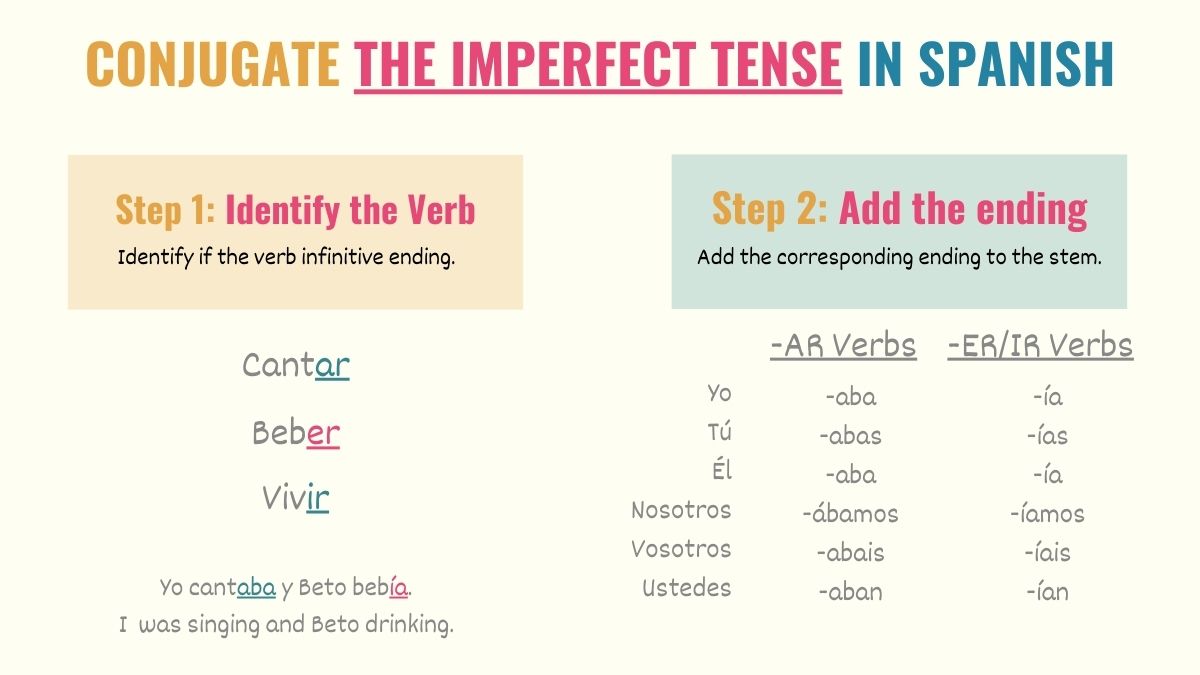
Esa noche hacía mucho frío.
That night was very cold.
A los chicos no les gustaba jugar con nosotras.
The boys didn’t like playing with us.
Elizabeth era la más chaparrita del salón.
Elizabeth was the shortest in the classroom.
Tip: There are only 3 irregular verbs in the imperfect tense.
Future tense
Just like in English, in Spanish, we use the future tense to talk about actions that will occur at some point. Unlike other tenses, to conjugate the Spanish future, you only need to add the following endings to the infinitive verb.
| Personal pronoun | Future endings |
|---|---|
| Yo | -é |
| Tú | -ás |
| Él / Ella / Usted | -á |
| Nosotros | -emos |
| Vosotros | -éis |
| Ellos | -án |
Yo no iré a trabajar mañana.
I will not go to work tomorrow.
La semana que viene viajaremos a Perú.
Next week, we will travel to Perú.
Mañana conocerás a mi familia.
Tomorrow you will meet my family.
Creo que Julián hablará contigo.
I think Julian will talk to you.
The endings remain the same for all -AR, -ER and -IR verbs, which makes this tense one of the easiest for Spanish beginners to learn.
Take Note: Irregular verbs in the future tense are stem-changing verbs, and to conjugate them, you’ll use the future endings shown above. The future tense in Spanish has more useful applications and in fact there are several variations of the tense that you can use for different situations. You can read our future tense guide to learn more about it.
Spanish conditional
The conditional tense in Spanish is used to:
- Talk about wishes.
- Talk about hypothetical situations
- Address someone politely.
- Make suggestions.
- Express about things that could have happened in the past.
Like the Spanish future tense, this tense is formed by adding the conditional endings to a verb in the infinitive form:
| Personal pronoun | Conditional endings |
|---|---|
| Yo | -ía |
| Tú | -ías |
| Él / Ella / Usted | -ía |
| Nosotros | -íamos |
| Vosotros | -íais |
| Ellos | -ían |
Si tuvieran tiempo, viajarían más seguido.
If they had time, they would travel more often.
Nos gustaría probar el helado de chocolate.
We would like to try the chocolate ice cream.
Te diría lo que pienso, pero te vas a enojar.
I would tell you what I think, but you’re going to get upset.
Like the future tense, the conditional tense in Spanish shares the same conjugation rules. You add the ending to the infinitive form of the verb and the endings above apply for all three types of verbs (-AR, -ER, and -IR).
Indicative Compound Tenses
Spanish compound tenses are tenses that are formed with two verbs: an auxiliary verb (haber) and a past participle verb. Haber can be conjugated to present, imperfect, future, and conditional tenses.
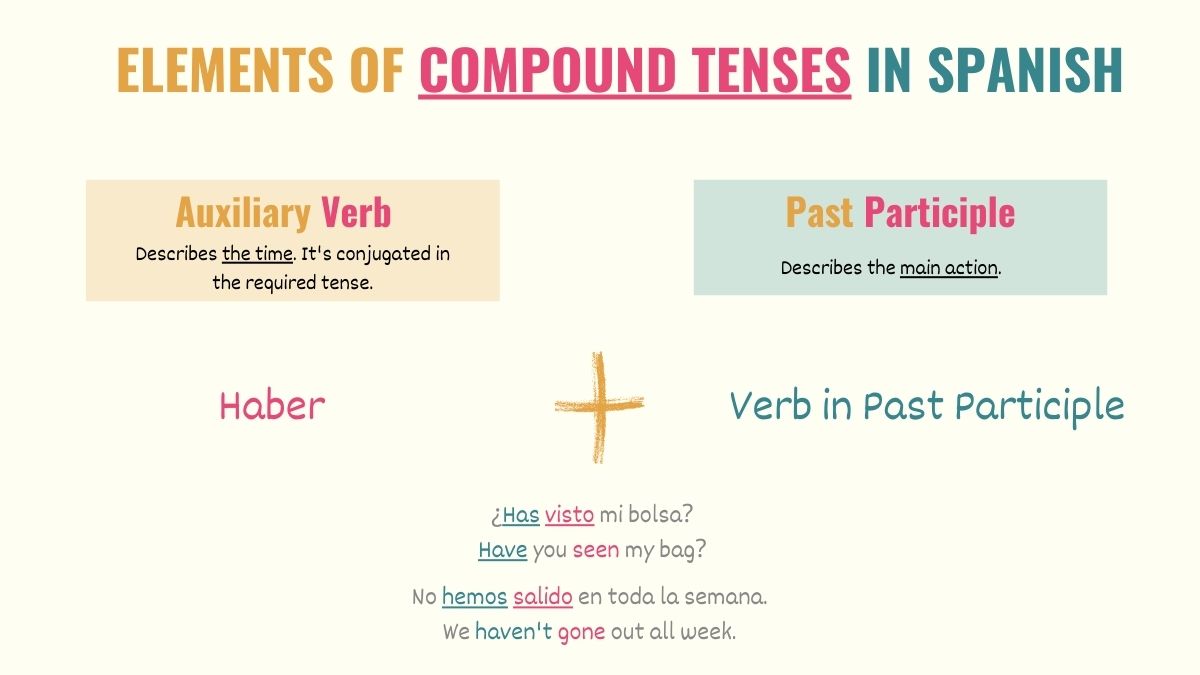
So, depending on the conjugation of the auxiliary verb, Spanish compound tenses are classified into:
- Present perfect: We use it to talk about life experiences or to express that a past action still continues in the present.
- Spanish pluperfect: A past tense that allows you to convey that a past action took place before another action. To create this tense, haber must be conjugated to the imperfect tense.
- Future perfect: It indicates that an action will be completed before a certain point in the future.
- Conditional perfect: In Spanish, the conditional perfect is used to talk about past possibilities. Since possibilities in the past can no longer be changed, this tense usually works with the subjunctive.
Check these examples:
Present perfect
Nunca he probado la cerveza.
I have never tried beer.
Mario se ha ido temprano.
Mario has left early.
Spanish pluperfect
Traje comida china, pero ya habían comido.
I brought Chinese food, but you guys had already eaten.
Cuando llegué, el avión ya había despegado.
When I arrived, the plane had taken off.
Future perfect
Para el jueves, me habré mudado.
I will have moved by Thursday.
Mañana habremos terminado nuestro proyecto.
Tomorrow we will have finished our project.
Conditional perfect
Si hubieras podido, ¿habrías cambiado algo?
If you could, would you have changed something?
Habría ido, pero no sabía que ibas a estar ahí.
I would have gone, but I didn’t know you would be there.
Spanish Imperative
Even though it’s often confused with a tense, the imperative is one of the three Spanish moods. Leaving its classification aside, the Spanish imperative is very useful because it allows you to give commands or instructions to others.
You’ll need the following endings to conjugate a verb to the imperative form. Notice that, in this case, we use fewer subject pronouns.
| -AR verbs | -ER verbs | -IR verbs | |
|---|---|---|---|
| Tú | -a | -e | -e |
| Usted | -e | -a | -a |
| Vosotros | -ad | -ed | -id |
| Ustedes | -en | -an | -an |
Alguien corte las cebollas, por favor.
Someone chop the onions, please.
Suzie, sube el volumen.
Suzie, turn up the volume.
¡Chicos, abran la puerta!
Guys, open the door!
If instead, you need to give negative commands (tell people what not to do), you’ll need the endings below:
| -AR verbs | -ER/IR verbs | |
|---|---|---|
| Tú | -es | -as |
| Usted | -e | -a |
| Vosotros | -éis | -áis |
| Ustedes | -en | -an |
[No] + [verb in negative imperative]
Niños, ¡no corran! Se van a caer.
Kids, don’t run! You’re going to fall.
Por favor, no le digan nada a Julie.
Please, don’t say anything to Julie.
Advanced Tip: In Spanish, the structure a + infinitive verb can also be used to give commands. However, these sentences are not nearly as common as the imperative and don’t have a direct English translation.
A + [infinitive verb]
¡A comer! La comida se está enfriando.
Come to have lunch. The food is getting cold.
¡Niños, a dormir! Mañana tienen escuela.
Kids, go to sleep! It’s school day tomorrow.
Spanish Subjunctive Tenses
Hands down, the subjunctive tenses are a must if you want to speak fluid Spanish. Fortunately, you only need to master four Spanish subjunctive tenses, which are:
Present subjunctive
In Spanish, the present subjunctive allows you to express uncertainty, wishes, and feelings about a certain situation. Additionally, we also use this tense to talk about hypothetical situations in the present.
The subjunctive endings for regular verbs are:
| -AR verbs | -ER / IR verbs | |
|---|---|---|
| Yo | -e | -a |
| Tú | -es | -as |
| Él / Ella / Usted | -e | -a |
| Nosotros | -emos | -amos |
| Vosotros | -éis | -áis |
| Ellos | -en | -an |
Ojalá te aumenten el salario.
I hope they raise your salary.
Espero que disfrutes tu viaje.
I hope you enjoy your trip.
Pregúntale a Ana, quizá ella pueda ayudarte.
Ask Ana; maybe she can help you.
Take Note: The subjunctive tense can be complicated because it doesn’t have a direct English translation. However, in Spanish, the distinction between indicative (claims and assertions) and subjunctive (wishes and uncertainties) is very clear.
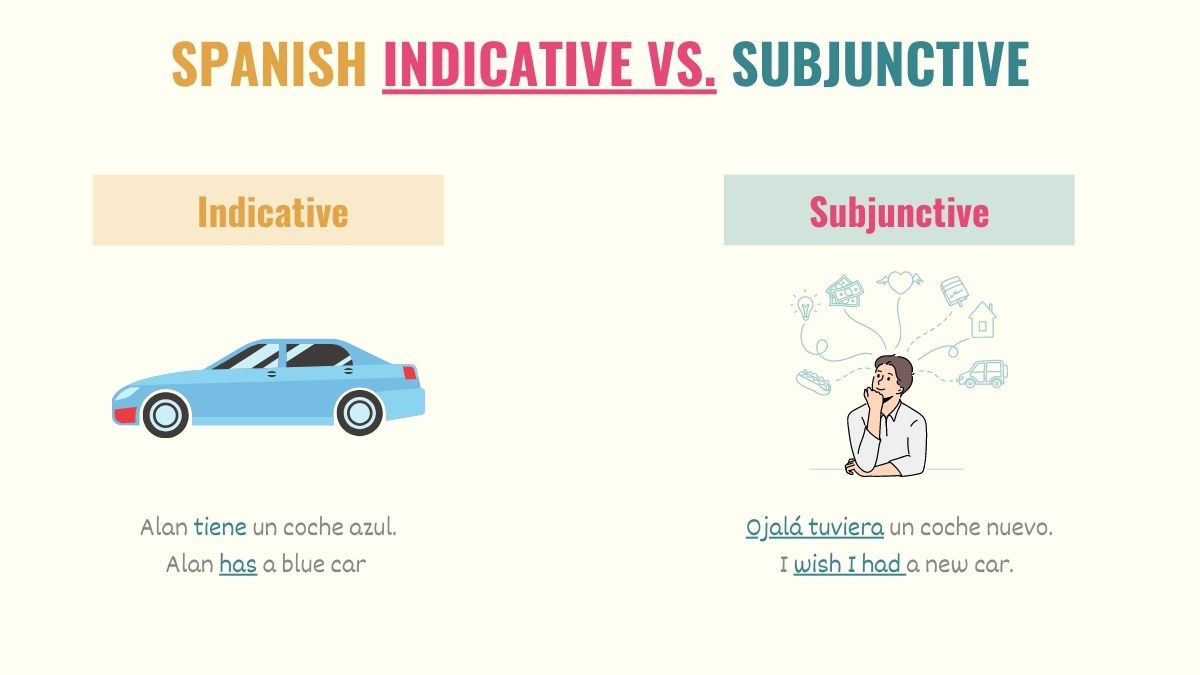
Imperfect subjunctive
As a quick overview, we use the Spanish imperfect subjunctive to talk about imaginary situations that are unlikely to happen, give advice and express wishes. For example:
Ojalá dejaras de molestarme.
I wish you stopped annoying me.
Larry me aconsejó que trabajara menos.
Larry advised me to work less.
Si me despertara más temprano, llegaría a tiempo al trabajo.
If I woke up earlier, I would arrive at work on time.
Take Note: As you can see in example #2, there are certain sentences where the subjunctive verb is translated as a verb in the infinitive form. This takes place with statements that have two subjects. In our example, those subjects will be Larry and me.
The endings that you use for this tense are:
| Personal pronouns | Imperfect subjunctive endings |
|---|---|
| Yo | -ra |
| Tú | -ras |
| Él / Ella / Usted | -ra |
| Nosotros | -ramos |
| Vosotros | -rais |
| Ellos | -ran |
Take Note: These conjugation endings are more appropriate for Latin American Spanish-speaking countries. In Castilian Spanish, the endings below are more common.
| Personal pronouns | -AR verbs | -ER / IR verbs |
|---|---|---|
| Yo | -se | -se |
| Tú | -ses | -ses |
| Él / Ella / Usted | -se | -se |
| Nosotros | -semos | -semos |
| Vosotros | -seis | -eseis |
| Ellos | -sen | -sen |
Spanish present perfect subjunctive
This subjunctive tense describes:
- Expectations and wishes.
- Things that are likely to happen.
- Our uncertainty about actions that may have occurred in the past.
As a Spanish compound tense, the Spanish present subjunctive is formed with the auxiliary verb haber and a past participle. In this case, you need to make sure to conjugate ‘haber’ in the present subjunctive:
| Subject | ´Haber´ present subjuntive |
|---|---|
| Yo | haya |
| Tú | hayas |
| Él / Ella / Usted | haya |
| Nosotros | hayamos |
| Vosotros | hayais |
| Ellos | hayan |
[‘Haber’ in present subjunctive] + [past participle verb]
Ojalá hayan encontrado a su perro.
I hope they have found their dog.
No creo que haya comido, se fue muy rápido.
I don’t think he has eaten; he left very quickly.
Es posible que Nora se haya ido con Tommy.
It’s possible that Nora has left with Tommy.
Spanish past perfect subjunctive
Like any other subjunctive tense, the Spanish past perfect subjunctive is also used to discuss hypothetical situations. However, this tense implies regret:
Si hubiera sabido, no me habría ido.
If I had known, I wouldn’t have left.
Ojalá nos hubiéramos conocido antes.
I wish we had met before.
Si le hubieras dicho antes, Tanya te habría perdonado.
If you had told her sooner, Tanya would have forgiven you.
As you can see, these examples convey certain regret and express a hypothetical situation of how things could have been. In the graphic below, you can see the formula to create the Spanish present perfect subjunctive.
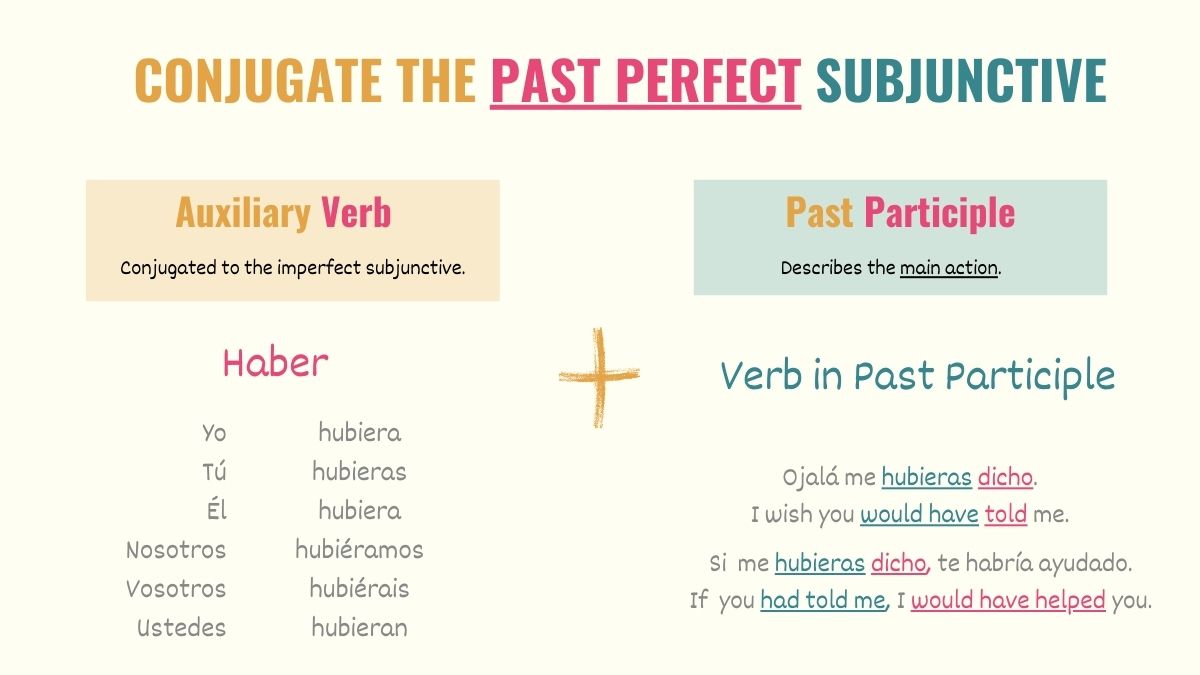
Spanish Moods
When trying to master Spanish tenses, you also need to understand the concept of Spanish moods. Moods refer to the intention or the way we express something. Based on this, Spanish has three moods: indicative, subjunctive and imperative.
The indicative mood expresses facts, assertions, and objective statements. As you have learned, we use different tenses to describe when these facts took place.
Yo hablo español.
I speak Spanish.
Doug aprendió español en la secundaria.
Doug learned Spanish in junior high.
The subjunctive mood expresses wishes, hypothetical situations, doubts, feelings and expectations. So, unlike the indicative, this mood doesn’t focus on real facts. In this case, you can also use different tenses to express when these wishes or hypothetical situations occurred. Check these examples below:
Ojalá hablara español más rápido.
I wish I spoke Spanish more quickly.
Si Doug hubiera aprendido español, tendría un mejor trabajo.
If Doug had learned Spanish, he would have a better job.
Finally, the imperative mood allows you to command someone to do something. This mood cannot be conjugated in any tense.
¡Habla en español! Necesitas practicar más.
Speak in Spanish! You need to practice more.
Aprende español y podrás tener un mejor trabajo.
Learn Spanish and you could have a better job.
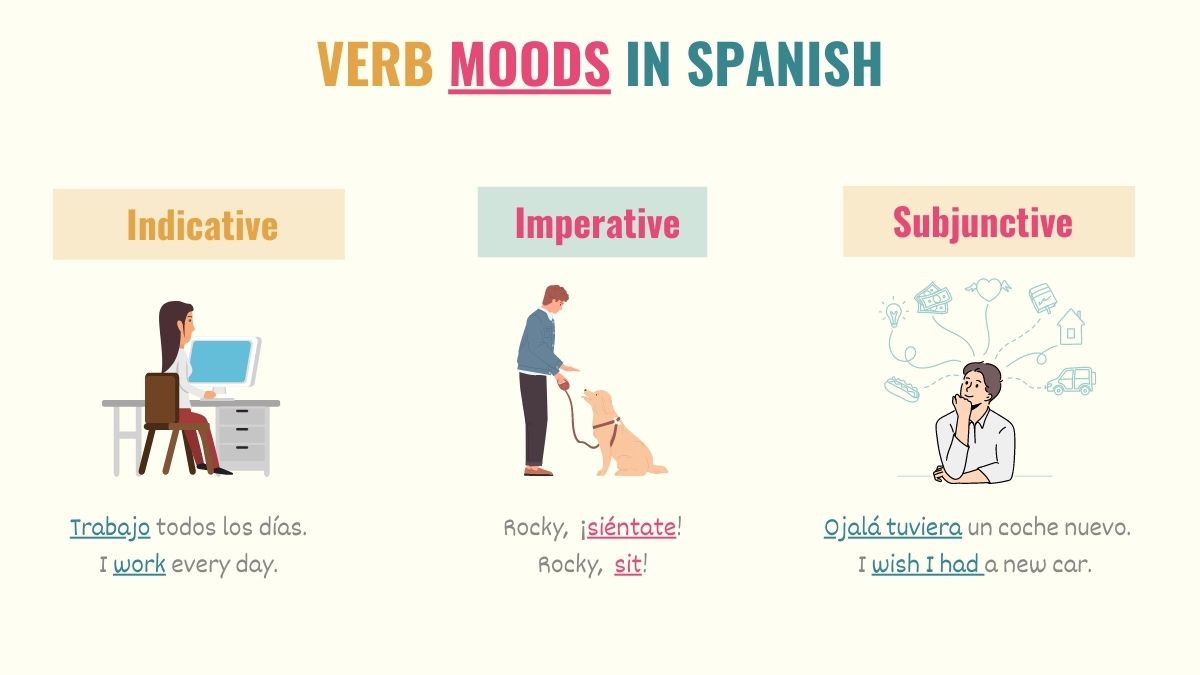
Bonus: Spanish Impersonal Verb Forms & Progressive Tenses
In simple terms, Spanish tenses describe when an action happens. As mentioned before, verb conjugations also explain who performed that action. However, impersonal verb forms do not convey this information. Spanish impersonal verb forms are:
Even though these verb forms don’t have the same features as Spanish tenses, they’re still crucial for you to understand. As you have learned, Spanish past participles are a key element when forming compound tenses.
[‘Haber’ conjugated] + [past participle]
No he hablado con Jim.
I haven’t spoke with Jim
Martha y yo hemos viajado a Europa varias veces.
Martha and I have traveled to Europe many times.
Infinitive verbs, on the other hand, are used after certain verbs such as poder, querer, ir, etc. Without them, any sentence you make with these verbs wouldn’t make sense.
Queremos ir al cine.
We want to go to the movies.
No podemos abrir la puerta.
We can’t open the door.
The last impersonal verb form is Spanish gerunds, which you’ll need to create progressive tenses in Spanish. You can think about progressive tenses as a derivative of the present, past, and future tenses. The main characteristic of progressive tenses is that they emphasize if an action is happening or continued for a certain period of time.
You can see these applications in the following examples with the Spanish progressive tense and the past progressive tense:
[‘Estar’ conjugated] + [gerund]
Klaus está cocinando pastel de carne.
Klaus is cooking meatloaf.
Estaba limpiando la cocina, ¿tú que estás haciendo?
I was cleaning the kitchen, what are you doing?
In Which Order Should You Learn the Spanish Tenses?
Spanish speakers regularly use all the 14 verb tenses you’ve learned. That said, when starting with this language, this is the sequence that I recommend you to follow to properly learn and master Spanish tenses:
- Present
- Preterite
- Imperfect
- Present perfect
- Future tenses
- Conditional
- Pluperfect
- Imperative
- Future perfect
- Conditional perfect
- Present subjunctive
- Present perfect subjunctive
- Imperfect subjunctive
- Past perfect subjunctive
Take Note: In Spanish, the subjunctive is as frequently used as the indicative tenses. However, you may want to wait until you have a better command of the indicative tenses before getting into the intricacies of the subjunctive.
Best Way to Learn Spanish Tenses
As you can imagine, Spanish verb tenses are crucial to holding a conversation. Here are some ideas that can help you learn tenses more effectively:
- Learn the conjugation endings: unfortunately, Spanish conjugations are far more complex than English because most tenses and subjects have their own ending. As a result, to learn a Spanish tense, you need to know its endings. As a tip, if you’re learning Mexican Spanish or any other form of Latin American Spanish, don’t worry about learning the conjugations for vosotros.
- Understand the context: each Spanish tense refers to a specific point in time and has different purposes. So, when listening to others speaking Spanish, try to understand the situation where they’re applying a tense.
- Create sentences in different tenses: once you know a couple of different tenses, you can start practicing by transforming a sentence into different tenses. This will allow you to see the different contexts where each verb tense is applied.
- Identify time markers: time markers are adverbs of time or expressions that refer to the exact moment when an action took place. Specific time markers usually trigger each Spanish tense. So, identifying some of these expressions can help you know when it’s the best moment to use a certain tense.
- Test your knowledge with practice quizzes: an easy way to see your progress and correct any potential mistakes is to assess your conjugations with different Spanish quizzes. To make the most out of this process, make sure you take note of your mistakes so you can improve them.
Key Points About Spanish Tenses
Spanish tenses can be confusing for many students. Here are some key points that you want to keep in mind:
- There are 14 highly used tenses in Spanish.
- Spanish tenses indicate the moment in time when an action takes place.
- Verb tenses in Spanish can be classified into simple or compound tenses.
- Compound tenses are formed with the verb haber conjugated to a certain tense (conjugation depends on which specific compound tense) and a past participle verb.
- Spanish indicative tenses describe facts, objective statements and assertions.
- Subjunctive tenses are used to talk about wishes, expectations, and hypothetical situations.
- Both moods and tenses relate to verbs. However, moods refer to the way we express something (whether it’s a fact or hypothetical), while tenses describe when something happened.
- The imperative mood is used to give commands.
- We use progressive tenses to emphasize that an action is taken at the moment of speaking.



